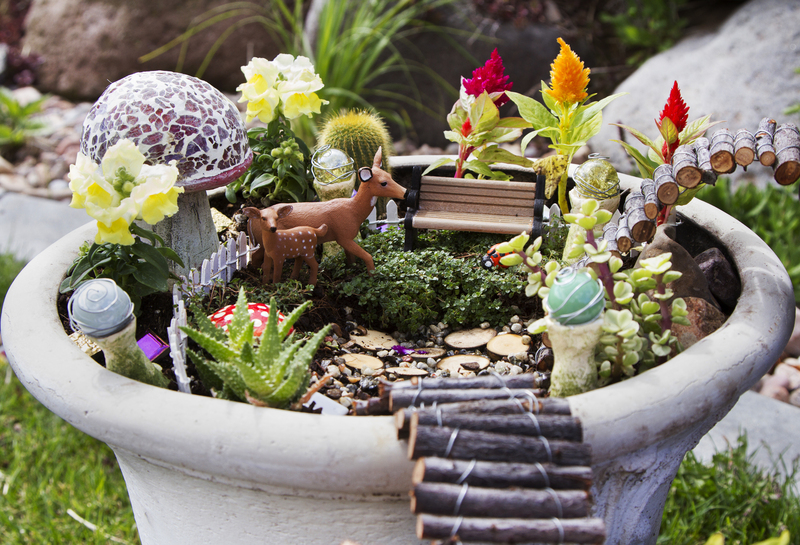Essential Tips to Arm Your Garden Against Weather Hazards
Posted on 21/05/2025
Essential Tips to Arm Your Garden Against Weather Hazards
Gardening brings a wealth of joy and satisfaction, yet every gardener knows the heartbreak extreme weather can cause. From relentless heatwaves and chilling frosts to torrential downpours and violent winds, weather poses some of the biggest threats to a healthy, thriving garden. If you want to safeguard your garden, it's crucial to proactively implement precautions and employ practical solutions. In this guide, you'll discover comprehensive, actionable advice to arm your garden against weather hazards--whatever nature throws your way.
Understanding the Most Common Weather Hazards for Gardens
To effectively protect your garden from weather hazards, you first need to identify the primary risks your region faces. Here are the most prevalent threats:
- Frost and Freezing Temperatures: Sudden cold snaps can wreak havoc on tender plants and destroy roots.
- Heatwaves and Drought: Extended hot spells dehydrate soil and stress vegetation.
- Heavy Rain and Flooding: Torrential rain can erode soil, drown roots, and destabilize plants.
- Strong Winds and Storms: Wind gusts break branches, uproot plants, and scatter debris.
- Hail: Hailstones can shred leaves, damage blossoms, and bruise fruit.
Assessing Your Local Weather Patterns
Begin by researching your local climate and identifying the most likely weather dangers throughout the year. The USDA Plant Hardiness Zones and local meteorological data are invaluable resources. This knowledge guides your garden planning and helps you choose plants naturally suited to your conditions, providing an essential layer of protection from the start.

1. Building a Resilient Garden Layout
A strong foundation is essential in the fight against adverse weather. Thoughtful garden design, plant selection, and strategic placement can significantly reduce weather impacts.
Choose Weather-Hardy Plants
Opt for plants known for their resilience in your climate zone. Native plants often outperform exotics as they have evolved to withstand local conditions. The more adapted your plants are, the more likely they'll bounce back from storms, drought, or frosts.
- Research local wildflowers, shrubs, and trees.
- Consider drought-tolerant plants for arid areas and moisture-loving varieties for wetter regions.
- Consult your local nursery or cooperative extension service for region-specific recommendations.
Layering and Positioning
Smart arrangement reduces wind damage and lessens the impact of heavy rainfall. Include windbreaks (like hedges or fences) on the windiest side of your property, and group delicate plants in more sheltered spots.
- Tall shrubs or small trees can shield smaller, sensitive species.
- Companion planting can also create a microclimate that is warmer or cooler, depending on your needs.
Consider Raised Beds and Slopes
Raised garden beds offer better drainage and help prevent waterlogging during storms. Build paths and beds perpendicular to the slope of your land to slow runoff and minimize erosion.
2. Water Management: Preparing for Droughts and Downpours
Water extremes can devastate an unprepared garden. Effective water management is key:
Install Mulch and Ground Covers
Mulching is an indispensable tool for weatherproofing your garden. Apply a thick, even layer (2-4 inches) of organic mulch--like straw, bark chips, or compost--around your plants.
- Mulch insulates roots against cold and heat.
- It retains soil moisture during droughts and reduces evaporation.
- It slows rainwater runoff, preventing erosion and nutrient loss.
Proper Drainage Solutions
Prevent standing water and root rot by amending heavy soils with organic matter, laying out French drains, or configuring swales and rain gardens. For flood-prone gardens, avoid low-lying areas for your most valuable plants.
- Use permeable pathways to allow water penetration.
- Consider installing rain barrels to capture and reuse stormwater.
Invest in Efficient Irrigation
During dry periods, consistent, deep watering is crucial. Drip irrigation and soaker hoses are efficient, delivering moisture directly to roots and minimizing waste.
- Water early in the morning or late in the afternoon to prevent evaporation.
- Adjust watering schedules depending on rainfall, temperature, and plant needs.
3. Shielding Against the Cold: Frost and Freeze Preparation
Nothing is more disheartening than losing tender buds or a season's worth of vegetables to a surprise frost. Here's how to protect your garden against sudden cold snaps:
Row Covers and Cloches
Covering plants with lightweight fabrics (frost cloths, old sheets, or row covers) can raise temperatures a few crucial degrees. For individual plants, use cloches--domes made from glass, plastic, or even cut-off milk jugs.
- Secure covers before sunset and remove them after temperatures rise the next morning.
- Do not let covers rest heavily on foliage to prevent freezing by contact.
Water Before a Freeze
Moist soil holds more heat than dry soil. Water your garden thoroughly the day before a forecasted frost to help retain ground warmth.
- Mulch further insulates roots and bulbs during cold snaps.
4. Battling Heat and Drought: Keeping Cool Under Pressure
Heat and drought can quickly stress or kill sensitive plants. Adopt these strategies to arm your garden against high temperatures:
Shade Cloth and Temporary Structures
Use shade cloths or temporary pergolas to shield delicate crops from direct sun during peak hours. Netting, old sheets, or even stacked pots can provide emergency shade in a pinch.
- Install supports so that the cloth does not touch the plants directly.
Prioritize Deep, Root-Level Watering
Watering deeply, but less frequently, encourages roots to grow downward seeking moisture, making plants more resilient to drought. Shallow, frequent sprinkling induces shallow roots and greater susceptibility.
- Mulch is your friend--again! Renew layers frequently in hot, dry weather.
5. Tackling Wind, Storms, and Hail
Windstorms and hail can devastate even the healthiest gardens. Here's how to weatherproof your garden from extreme storms:
Establish Sturdy Windbreaks
Hedges, fences, trellises, or even a row of sunflowers--anything that slows and filters the wind can help. Choose evergreen shrubs or sturdy wooden fencing on the windward side of your garden.
Staking and Guying
Provide extra support to tall or top-heavy plants. Use stakes, cages, or trellises and secure with soft ties to prevent breakage.
- For trees, use proper staking techniques and check ties frequently so they don't constrict growth.
Hail Nets and Covers
Protect vulnerable areas with hail netting, wire mesh, or temporary covers during forecasted hailstorms. Review weather warnings and be ready to act quickly.
6. Enhancing Soil Health for Resilience
Healthy soil is the backbone of weather-resilient gardening. Here's how to improve soil for increased weather resistance:
Regularly Add Organic Matter
Compost, manure, and leaf mold boost the soil's water retention and drainage capacity, making it less susceptible to both flooding and drought.
Practice No-Till Gardening
Minimize soil disturbance to improve structure, reduce erosion, and preserve beneficial organisms that help gardens recover from environmental stress.
7. Smart Monitoring and Maintenance
Preparedness and vigilance are your greatest allies. Arm yourself with regular observation and timely action:
- Monitor local weather forecasts and garden microclimates.
- Remove weak, dead, or diseased branches to prevent wind tossing and breakage.
- Check stakes and covers after storms and make repairs as needed.
- Adjust garden care strategies throughout the year, anticipating the next possible weather event.

8. Having an Emergency Weather Plan
Sometimes, despite best efforts, disaster strikes. Give your garden the best chance at recovery by creating a plan:
- Keep row covers, extra mulch, and repair materials on hand at all times.
- Develop a system for rapidly draining standing water or staking toppled plants.
- Know which plants are your highest priority to save and which can be replanted if lost.
After any severe weather event, inspect your garden for damage. Remove debris, trim broken stems, and prune back affected areas to encourage regrowth. Most importantly, be patient--many plants bounce back with a bit of attention.
Conclusion: Making Your Garden Weather-Resilient
Climate change and unpredictable weather have made garden protection an even bigger priority for modern green thumbs. With these essential tips, you can significantly harden your garden against weather hazards and enjoy a lush, flourishing landscape year-round. By planning ahead, making strategic choices, and remaining vigilant, you'll ensure your garden weathers the storm--no matter what comes its way.
Remember, gardening is as much about adaptation as anticipation. Use these strategies to arm your garden against weather hazards and cultivate both beauty and resilience for seasons to come.

